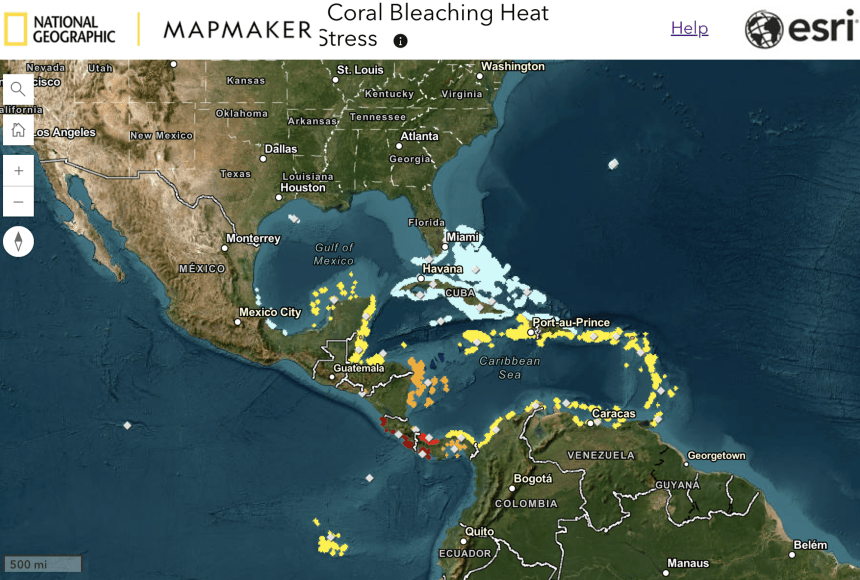Shallow water coral are ancient, sessile animals that rely on a symbiotic relationship with a photosynthetic alga called zooxanthellae (pronounced zo-UH-zan-thuh-lay). Deep-sea corals do not have the same symbiotic relationship with zooxanthellae as the water is too deep for light to reach. Together these colonial organisms work together to build reefs, some of which are so large they can be seen from space. A coral reef is sometimes called the “rainforest of the sea” because it is a very biodiverse habitat.
A coral is made up of hundreds or thousands of tiny polyps. The polyps absorb nutrients carried by ocean currents and then secrete calcium carbonate (limestone) to build the coral’s skeleton which is fixed to rocks or older dead corals. Zooxanthellae live in the polyps and transform their waste into oxygen as they photosynthesize.
Coral bleaching occurs when corals are stressed by changes in their environment. Changes to the amount of light, the water temperature or chemistry (ocean acidification or pollution), sedimentation, or available nutrients can cause the corals to expel the symbiotic zooxanthellae. This turns coral white. When coral experience a bleaching event they are not dead. They can survive bleaching, but they are more susceptible to stress and additional bleaching events, which can lead to their death.
Coral reefs are incredibly biodiverse habitats supporting more species per unit area than any other marine environment and scientists hypothesize that there are millions more we have yet to discover. These biodiverse ecosystems host plants and animals that have extracts from which humans have used to develop treatments for many conditions such as asthma, arthritis, and cancer. With many species not yet identified, losing reefs could prevent the discovery of out next medicine.
Additionally, coral reefs support both commercial and subsistent fishing. This is critical when approximately three billion people globally rely on sea food as their primary source of protein. Tourism to coral reefs brings in money and provides jobs to local communities as people visit coral reefs. Many indigenous peoples such as the Toores Strait Islanders (Australia), and native Hawaiians (United States). Coral reefs safegaurd coasts by reducing the energy waves have limiting storm damage and erosion.
The daily updating dataset was collected by the National Oceanic and Atmospheric Administration’s (NOAA) Coral Reef Watch (CRW) program. NOAA uses satellites to monitor coral reefs globally and model them to monitor and predict large coral bleaching events. This dataset shows a region's alert level. The alert level is “an index of the likelihood of coral bleaching, scaled from zero (no heat stress) to four (coral mortality likely) based on:”
- sea surface temperature: the average temperature of the surface of the ocean measured by satellites.
- Hotspots: how many degrees the temperature is above what the coral can tolerate safely.
- temperature anomaly: how much the temperature of the ocean surface differs from the historical average measured from 1982-2010.
- degree heating weeks: the amount of time the corals have experienced heat stress.
You can help protect coral reefs by:
- Disposing of your trash properly and recycling if you can. Take it one step further and collect data on pollution in your neighborhood.
- Avoid fertilizers, herbicides, or pesticides when you can. While these chemicals help our gardens grow and our yards look nice, using too much can cause them to run off into our waterways and eventually end up in our ocean.
- Minimize stormwater runoff by using rain barrels, planting a rain garden, and using less water.
- Drive less. This lowers your carbon emissions and reduces ocean acidification.
- Save energy when you can.
- Volunteer for a reef cleanup if you live near one or are visiting one.
- Teach others about coral reefs and what they can do to make an impact.
